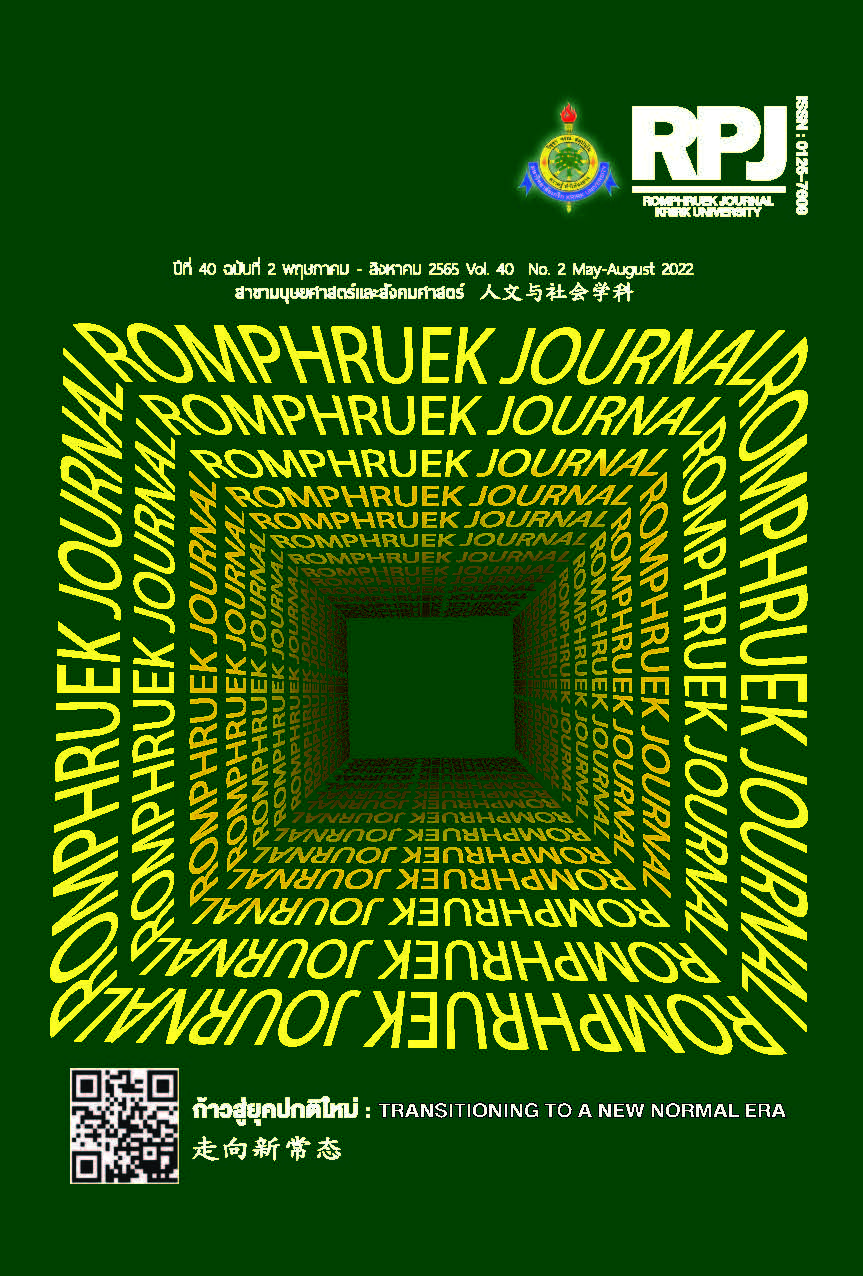Relationship Between Challenging Work, Creative Problem-Solving Capacity, and Innovation Performance, With Knowledge Sharing as a Moderator
Main Article Content
Abstract
The objective of this research was to study the relationship between challenging work, creative problem-solving capacity, and innovation performance with knowledge sharing as a moderator. The population in this study are officers from the department of disaster prevention and mitigation. The questionnaire was used as a research tool. The data was collected using stratified sampling from central and regional disaster prevention and mitigation officers. A total of 379 complete questionnaires were collected. The statistics used for data analysis were frequency, percentage, regression coefficients, and using the program process to test the effect of the moderator. The results showed that 1) Challenging work was positively correlated to creative problem-solving capacity, and innovative performance with statistical significance at 0.01 and 0.001, respectively. 2) Creative problem-solving capacity was positively correlated to innovation performance with statistical significance at the 0.001 level 3) knowledge sharing is a moderator in the relationship between challenging tasks, creative problem-solving capacity, and innovative performance with statistically significant at 0.01 and 0.05.
Article Details

This work is licensed under a Creative Commons Attribution-NonCommercial-NoDerivatives 4.0 International License.
Every article published in the Romphruek Journal of the Humanities and Social Sciences is the opinion and point of view of the authors. Thery're not the viewpoint of Krirk University or the editored department. Any part or all of the articles for pablication must be clearly cited.
References
กรมป้องกันและบรรเทาสาธารณภัย. (2562). รายงานสรุปข้อมูลกำลังคนของส่วนราชการกรมป้องกันและบรรเทาสาธารณภัย. (6 พฤษภาคม 2563) สืบค้นจาก http://person.diaster. go.th/inner.personnel-4.183/downloadmenu_3967.
ทศพร บุญวัชราภัย. (2558(. ความคิดสร้างสรรค์ขององค์การเพื่อสร้างนวัตกรรมบริการและผลการดำเนินงานของธุรกิจ : ปรากฏการณ์เชิงประจักษ์ของโรงแรมบูติกไทย. วิทยานิพนธ์ปริญญาดุษฎีบัณฑิต สาขาวิชาการจัดการ มหาวิทยาลัยศิลปากร, กรุงเทพฯ.
มนตรี พิริยะกุล. (2562). การวิเคราะห์อิทธิพลการกำกับด้วยโปรแกรม Process. วารสารวิชาการเทคโนโลยีอุตสาหกรรม, 15(2), 144-161.
สุเทพ ดีเยี่ยม และ ณัฏยาณี บุญทองคำ. (2563). การสร้างนวัตกรรมในบริบทภาครัฐไทย. วารสารการบริหารนิติบุคคลและนวัตกรรมท้องถิ่น, 6(3), 287-299.
สำนักงานคณะกรรมการข้าราชการพลเรือน. (2560). ระบบราชการไทยในบริบทไทยแลนด์ 4.0. (6 พฤษภาคม 2563) สืบค้นจาก https://www.ocsc.go.th/sites/default/files/document/thai-gov-system-context-thailand-4-0.pdf.
Almeshal, S. A., & Aloud, G.N. (2019). The impact of ethical climate on creative problem –solving capacity : An empirical study on human resource employees in saudi arabia. Journal of Economics, Management and Trade, 24(1), 1-13.
Amabile, T. M., Conti, R., Coon, H., Lazenby, J., & Herron, M. (1996). Assessing the work environment for creativity. The Academy of Management Journal, 39(5), 1154–1184.
Amabile, T. M. (1997). Motivating creativity in organizations : On doing what you love and loving what you do. California Management Review, 40(1), 39-58.
Carmeli, A., Cohen-Meitar, R., & Elizur, D. (2007). The role of job challenge and organizational identification in enhancing creative behavior among employees in the workplace. Journal of Creative Behavior, 41(2), 75-90.
Carmeli, A., Gelbard, R., & Reiter-Palmon, R. (2013). Leadership, creative problem-solving capacity, and creative performance : The importance of knowledge sharing. Human Resource Management, 52(1), 95–122.
Carmeli, A., Sheaffer, Z., Binyamin, G., Reiter-Palmon, R., & Shimoni, T. (2013). Transformational leadership and creative problem-solving : The mediating role of psychological safety and reflexivity. The Journal of Creative Behavior, 48(2), 115–135.
Costa, V., & Monteiro, S. (2016). Key knowledge management processes for innovation : A systematic literature review. VINE Journal of Information andKnowledge Management Systems, 46(3), 386–410.
Cronbach, L. J. (1990). Essentials of psychological testing. New York : Harpar and Row.
Fomujang, V. A., Wu, C., & Tassang, A. (2019). The assessment of a creative climate within an organization. International Journal of Science and Research (IJSR), 8(3), 310-317.
Hackman, J. R., & Oldham, G. R. (1980). Work redesign. Reading, MA : Addison-Wesley.
Hair, J. F., Black, W. C., Babin, B. J., Anderson, R. E., & Tatham, R. L. (2006). Multivariate data analysis. Upper Saddle River, NJ : Pearson Prentice Hall.
Hayes, A. F., & Rockwood, N. J. (2020). Conditional process analysis : concepts, computation, and advances in the modeling of the contingencies of mechanisms. American Behavioral Scientist, 64(1), 19–54.
Hu, M.-L.M., Horng, J.-S., & Sun, Y.-H.C. (2009). Hospitality teams : knowledge sharing and service innovation performance. Tourism Management, 30(1), 41-50.
Isaksen, S.G. (2007). The climate for transformation : lessons for leaders. Creativity and Innovation Management, 16(1), 3-15.
Lunenburg, F.C. (2011). Motivating by enriching jobs to make them more interesting and challenging. International Journal of Management, Business, and Administration, 15(1), 1-11.
Mitchell, I. K., & Walinga, J. (2017). The creative imperative : the role of creativity, creative problem solving and insight as key drivers for sustainability. Journal of Cleaner Production, 140(3), 1872-1884.
Muñoz-Pascual L., Galende J., & Curado C. (2021). Contributions to sustainability in SMEs : human resources, sustainable product innovation performance, and the mediating role of employee creativity, Sustainability, 13(4), 1-20.
Prajogo, D. I., & Ahmed, P. K. (2006). Relationships between innovation stimulus, innovation capacity, and innovation performance. R&D Management, 36(5), 499-515.
Rovinelli, R., & Hambleton, R. (1976). On the use of content specialists in the assessment of criterion-referenced test item validity. Paper Presented at the Annual Meeting of the American Educational Research Association 60 th April 19-23, 1976 San Francisco California, 37.
Singh, S. K., Gupta, S., Busso, D., & Kamboj, S. (2021). Top management knowledge value, knowledge sharing practices, open innovation and organizational performance. Journal of Business Research, 128(1), 788-798.
Steen, T., & Schott, C. (2018). Public sector employees in a challenging work environment. Public Administration, 97(1), 3–10.
Sun, Y., Hu, X., & Ding, Y. (2019). Learning or relaxing : how do challenge stressors stimulate employee creativity?. Sustainability, 11(6),1-20.
Treffinger, D. J. (1995). Creative problem solving : overview and educational implications. Educational Psychology Review, 7(3), 301-312.
Yamane, T. (1967). Statistics, An Introductory Analysis. New York : Harper and Row.

